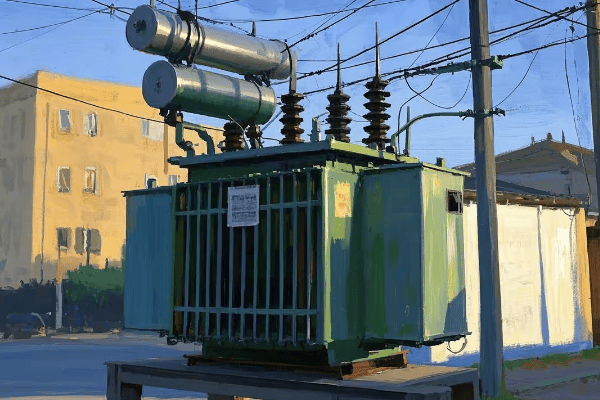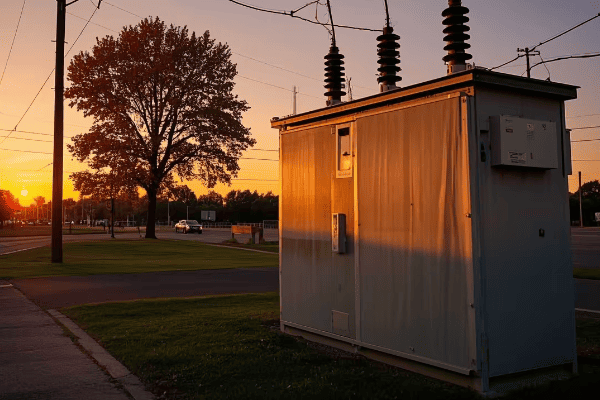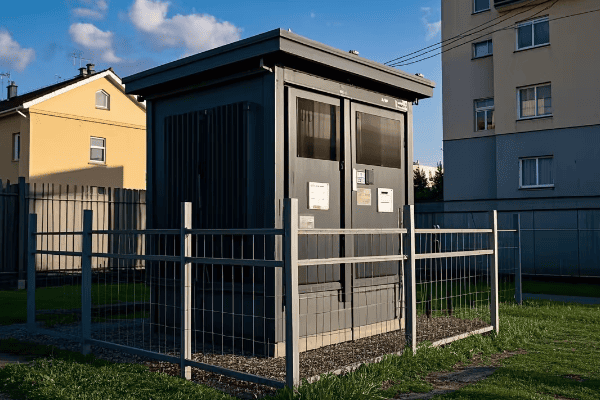What Is a Electric Transformer: Powering the Future of Smart Energy Grids?
Have you ever wondered how electricity travels safely from power plants to your home? The answer lies in a device you rarely see but heavily rely on: the electric transformer.
An electric transformer is a device that changes the voltage of electrical power. It allows electricity to be transmitted efficiently over long distances and then safely used in our homes and businesses. In smart energy grids, transformers are evolving to become key enablers of advanced power management and distribution.

As an electrical engineer with years of experience in the power industry, I’ve seen firsthand how crucial these devices are. Let’s explore the world of electric transformers and discover how they’re shaping the future of our power systems.
The Core Functionality: How Electric Transformers Drive Modern Power Systems?
Imagine trying to pour water from a fire hose into a drinking glass. That’s similar to the challenge of getting electricity from power plants to your home. Transformers are the solution to this problem.
Electric transformers drive modern power systems by changing voltage levels. They increase voltage at power plants for efficient long-distance transmission, then decrease it in stages for safe local distribution and use. This process ensures power reaches consumers efficiently and safely.

Let’s dive deeper into how transformers work:
Electromagnetic Induction: The Heart of Transformer Operation
Transformers work on a principle called electromagnetic induction:
- The primary coil receives alternating current (AC) power.
- This creates a changing magnetic field in the transformer’s core.
- The changing field induces a voltage in the secondary coil.
- The voltage in the secondary coil depends on the ratio of turns in the two coils.
Voltage Transformation
Transformers can increase or decrease voltage:
- If the secondary coil has more turns than the primary, voltage increases.
- If it has fewer turns, voltage decreases.
- The voltage ratio equals the turns ratio.
Power Conservation
In an ideal transformer:
- Input power equals output power (minus small losses).
- As voltage increases, current decreases proportionally, and vice versa.
- This is why high voltage is used for transmission (lower current, lower losses).
Here’s a simple comparison of transformers with different turn ratios:
| Primary Turns | Secondary Turns | Input Voltage | Output Voltage | Type |
|---|---|---|---|---|
| 100 | 1000 | 120 V | 1200 V | Step-up |
| 1000 | 100 | 12000 V | 1200 V | Step-down |
| 100 | 100 | 120 V | 120 V | Isolation |
I remember the first time I explained these principles to a group of engineering students. To demonstrate, we built a simple transformer using two coils of wire and an iron rod. When we connected one coil to a battery through a switch, the students were amazed to see the light bulb connected to the other coil flicker as we opened and closed the switch. It was a powerful demonstration of how energy can be transferred between circuits without a direct electrical connection.
Understanding these core principles is crucial for anyone working with electrical systems. They explain why transformers are so effective at changing voltage levels and why they’re so important in our power grid. From the massive transformers at power plants to the tiny ones in your phone charger, they all work on these same basic principles. It’s a testament to the elegance and power of electromagnetic induction, a phenomenon that continues to shape our electrical world.
Smart Grid Enablers: The Crucial Role of Transformers in Next-Generation Energy Networks?
Have you ever wondered how our power grid is becoming "smarter"? The answer lies in the evolution of its components, with transformers playing a starring role.
In next-generation energy networks, electric transformers are evolving into smart devices. They now incorporate sensors, communication capabilities, and advanced analytics. This allows for real-time monitoring, predictive maintenance, and more efficient grid management, making transformers crucial enablers of smart grids.

Let’s explore how transformers are enabling smart grids:
Real-Time Monitoring and Diagnostics
Smart transformers are always on watch:
-
Integrated Sensors:
- Monitor key parameters like temperature, oil condition, and load.
- Provide real-time data on transformer health and performance.
-
Advanced Analytics:
- Use artificial intelligence to analyze sensor data.
- Can predict potential issues before they cause failures.
Communication and Grid Integration
Smart transformers are becoming part of the Internet of Things (IoT):
-
Two-Way Communication:
- Can send data to control centers and receive commands.
- Enables better coordination with other grid components.
-
Grid Optimization:
- Help balance loads and manage power flow more efficiently.
- Can adapt to changing grid conditions in real-time.
Enhanced Power Quality Management
Smart transformers help maintain stable and clean power:
-
Voltage Regulation:
- Use on-load tap changers to adjust voltage in real-time.
- Maintain stable voltage despite fluctuations in supply or demand.
-
Harmonic Mitigation:
- Detect and mitigate harmonic distortions in the power supply.
- Crucial for maintaining power quality with increasing use of electronic devices.
Here’s a comparison of traditional and smart transformer features:
| Feature | Traditional Transformer | Smart Transformer |
|---|---|---|
| Monitoring | Basic gauges | Real-time digital monitoring |
| Communication | None or minimal | Two-way with grid systems |
| Maintenance | Time-based | Condition-based predictive |
| Voltage Regulation | Fixed or limited adjustment | Dynamic, real-time adjustment |
| Power Quality Control | Passive | Active management and correction |
I recently visited a newly upgraded substation that showcased these smart transformers. The difference was striking. The new units had touchscreen interfaces displaying real-time data. The substation operator showed me how they could adjust settings remotely and even predict potential issues weeks in advance. During my visit, the system detected a minor anomaly in one transformer and automatically adjusted loads to compensate, preventing any disruption in service. It was like watching the future of power distribution unfold before my eyes.
Smart transformers are more than just an upgrade to existing technology. They’re a fundamental shift in how we manage and interact with our power distribution systems. As we move towards a more distributed, renewable-based, and digitally-driven energy future, these smart transformers will play a crucial role. They’re not just reacting to changes; they’re anticipating and adapting to them in real-time, paving the way for more efficient, reliable, and flexible smart grids.
Evolving for Tomorrow: Innovations in Electric Transformer Technology for Future Energy Needs?
Have you ever thought about how our power systems will keep up with the growing demand for clean, efficient energy? The answer lies in the continuous evolution of transformer technology.
Electric transformer technology is evolving to meet future energy needs. Innovations include the use of advanced materials, integration of power electronics, and development of solid-state transformers. These advancements aim to improve efficiency, reduce size and weight, and enhance the grid’s ability to integrate renewable energy sources.

Let’s explore some of the key innovations in transformer technology:
Advanced Materials
New materials are pushing the boundaries of transformer performance:
-
Amorphous Metal Cores:
- Reduce no-load losses by up to 70% compared to traditional silicon steel.
- Improve overall transformer efficiency.
-
High-Temperature Superconducting (HTS) Transformers:
- Use superconducting materials for windings.
- Offer higher efficiency and smaller size, but still in development stage.
Power Electronics Integration
The merger of transformers and power electronics is creating new possibilities:
-
Solid-State Transformers (SSTs):
- Use power electronics to convert power, offering more control.
- Can easily integrate AC and DC systems, important for renewable energy and electric vehicle charging.
-
Hybrid Transformers:
- Combine traditional transformer technology with power electronics.
- Offer improved voltage regulation and power quality control.
Smart Features and Connectivity
Transformers are becoming smarter and more connected:
-
IoT Integration:
- Incorporate sensors and communication capabilities.
- Enable real-time monitoring and predictive maintenance.
-
AI and Machine Learning:
- Use advanced algorithms to optimize performance.
- Predict and prevent potential issues before they occur.
Here’s a comparison of traditional and future transformer technologies:
| Feature | Traditional Transformer | Future Transformer |
|---|---|---|
| Core Material | Silicon Steel | Amorphous Metal or HTS |
| Power Conversion | Electromagnetic | Solid-State Electronics |
| Size/Weight | Large and Heavy | Compact and Lightweight |
| Efficiency | 95-98% | 99%+ |
| Smart Features | Limited or None | Extensive IoT and AI Integration |
I recently had the opportunity to work on a pilot project testing solid-state transformers for a microgrid application. The flexibility these devices offered was impressive. We could seamlessly integrate solar panels, battery storage, and even electric vehicle charging stations. The SST could handle bidirectional power flow, convert between AC and DC, and adjust voltage levels on the fly. It was like having a Swiss Army knife for power management.
These innovations in transformer technology are not just incremental improvements. They represent a paradigm shift in how we think about and manage power distribution. As we move towards a more decentralized, renewable-based energy system, these advanced transformers will be key enablers. They’ll help us create more flexible, efficient, and resilient power grids capable of meeting the complex energy needs of the future.
Anatomy of Power: Key Components and Types of Electric Transformers in Smart Grids?
Have you ever wondered what’s inside those mysterious boxes you see in electrical substations? Let’s unravel the anatomy of electric transformers and explore how different types fit into smart grids.
Electric transformers in smart grids consist of several key components: the core, windings, insulation, and cooling system. Various types of transformers, from power transformers to distribution and instrument transformers, work together in smart grids. Each type is optimized for specific functions in the power system.

Let’s dive into the anatomy and types of transformers in smart grids:
Key Components of a Transformer
-
Core:
- Made of thin layers of silicon steel (laminations).
- Provides a path for the magnetic field.
- In smart transformers, may use advanced materials like amorphous metals.
-
Windings:
- Primary winding: Receives input power.
- Secondary winding: Delivers output power.
- In smart grids, may incorporate sensors for real-time monitoring.
-
Insulation:
- Prevents short circuits between windings and core.
- Materials include paper, oil, and advanced polymers.
-
Cooling System:
- Manages heat generated during operation.
- In smart transformers, may have advanced monitoring and control.
Types of Transformers in Smart Grids
-
Power Transformers:
- Used in power plants and major substations.
- In smart grids, often equipped with advanced monitoring and control systems.
-
Distribution Transformers:
- Found in neighborhoods and on utility poles.
- In smart grids, may have communication capabilities for real-time load management.
-
Instrument Transformers:
- Include current transformers (CTs) and voltage transformers (VTs).
- In smart grids, provide accurate measurements for advanced metering and protection systems.
-
Phase-Shifting Transformers:
- Control power flow in transmission systems.
- Crucial for managing power flow in complex smart grid networks.
-
Solid-State Transformers:
- Emerging technology combining power electronics with transformer functions.
- Offer unprecedented control and flexibility in smart grid applications.
Here’s a comparison of different transformer types in smart grids:
| Type | Primary Function | Smart Grid Enhancement |
|---|---|---|
| Power | Voltage transformation for transmission | Real-time monitoring and adaptive control |
| Distribution | Voltage reduction for end-users | Load management and demand response |
| Instrument | Measurement and protection | High-accuracy data for grid analytics |
| Phase-Shifting | Power flow control | Optimized transmission in complex networks |
| Solid-State | Flexible power conversion | Integration of AC/DC systems and renewables |
I remember working on a project to upgrade a city’s power infrastructure to a smart grid system. We had to consider each type of transformer and how it would fit into the new, more intelligent network. The power transformers at the main substation were equipped with advanced sensors and communication systems, allowing real-time monitoring and control. The distribution transformers in neighborhoods were upgraded to include smart metering capabilities, enabling more efficient load management. Even the instrument transformers were replaced with more accurate models to provide precise data for the grid management system.
Understanding the anatomy and types of transformers is crucial for anyone working with smart grids. Each component and each type of transformer plays a vital role in creating a more efficient, reliable, and flexible power system. As our grids become smarter, the transformers within them are evolving to meet new challenges and opportunities, shaping the future of our energy infrastructure.
Efficiency Unleashed: Electric Transformers as the Backbone of Smart Energy Distribution?
Have you ever wondered how we can make our power grids more efficient? The answer lies in the evolution of one of its most crucial components: the electric transformer.
Electric transformers are becoming the backbone of smart energy distribution by dramatically improving efficiency. Modern transformers use advanced materials and designs to minimize losses, incorporate smart features for optimal operation, and enable better integration of renewable energy sources. This results in more efficient, reliable, and sustainable power distribution.

Let’s explore how transformers are unleashing efficiency in smart energy distribution:
Minimizing Energy Losses
Modern transformers are designed to reduce energy losses:
-
Advanced Core Materials:
- Use of amorphous metals or advanced silicon steel.
- Can reduce no-load losses by up to 70% compared to traditional materials.
-
Improved Winding Design:
- Use of copper instead of aluminum for lower resistance.
- Advanced winding geometries to reduce eddy currents.
Smart Load Management
Transformers in smart grids can adapt to changing load conditions:
-
On-Load Tap Changers (OLTC):
- Adjust voltage ratios in real-time to optimize efficiency.
- Respond to changing load demands automatically.
-
Dynamic Rating Systems:
- Monitor transformer conditions to allow safe overloading when needed.
- Increase capacity utilization without compromising lifespan.
Renewable Energy Integration
Transformers play a key role in integrating renewable sources:
-
Bidirectional Power Flow:
- Handle power flowing both to and from the grid.
- Essential for integrating distributed renewable sources.
-
Harmonic Mitigation:
- Manage power quality issues associated with renewable energy inverters.
- Ensure stable and clean power supply.
Here’s a comparison of efficiency features in traditional vs. smart transformers:
| Feature | Traditional Transformer | Smart Transformer |
|---|---|---|
| Core Loss | 0.5-1% of rated power | 0.1-0.3% of rated power |
| Load Management | Fixed capacity | Dynamic capacity utilization |
| Renewable Integration | Limited capability | Advanced features for renewables |
| Monitoring | Basic or none | Real-time efficiency optimization |
| Lifespan | Fixed design life | Extended through smart management |
I once worked on a project to upgrade a city’s distribution network with smart transformers. The results were impressive. Overall energy losses in the system dropped by 20%. The new transformers could handle the variable output from a nearby solar farm much more efficiently. During peak demand periods, the smart load management features allowed us to safely utilize more capacity, reducing the need for additional infrastructure. It was a clear demonstration of how these advanced transformers can serve as the backbone of a more efficient and flexible energy distribution system.
Smart transformers are more than just efficient power conversion devices; they’re active participants in creating a more sustainable energy future. By minimizing losses, adapting to changing loads, and facilitating the integration of renewable energy, they’re helping to create power grids that are not only more efficient but also more resilient and environmentally friendly. As we continue to face the challenges of increasing energy demand and the need for cleaner power sources, these smart transformers will play an increasingly crucial role in shaping our energy landscape.
Conclusion
Electric transformers are evolving to power smart energy grids of the future. They’re becoming more efficient, smarter, and adaptable, enabling better power management, renewable integration, and overall grid performance. These advancements are crucial for a sustainable,
Free CHBEB Transformer Catalog Download
Get the full range of CHBEB transformers in one catalog.
Includes oil-immersed, dry-type, pad-mounted, and custom solutions.
Quick Message
Request A free quote
We'd like to work with you
- +86 15558785111
- [email protected]
- +86 15558785111
What We Do
CHINA BEI ER BIAN (CHBEB) GROUP, with 218 million in registered capital, originated from Beijing Beierbian Transformer Group. Headquartered in Beijing for R&D, it operates major production bases in Nanjing and Yueqing, producing high-quality products.
Latest Product
address
BeiJing
No 3,RongJing East Road,BeiJing Economic Technological Development Area,BeiJing,China
JiangSu
No 7️Xiangfeng Road,Jiangning,NanJing,JiangSu,China
WenZhou
No.211, Wei 16 Road, Industrial Zone, Yueqing, Wenzhou, Zhejiang, China.
XiangYang Industrial Zone ,YueQing,WenZhou,ZheJiang,China
contact us
- [email protected]
- +86 13057780111
- +86 13057780111
- +86 15558785111
Copyright © Bei Er Bian Group


